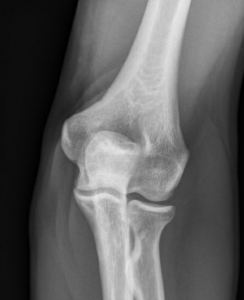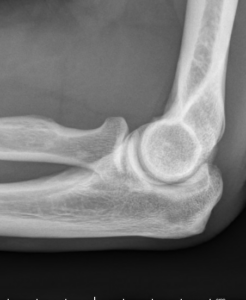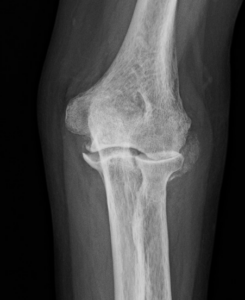Elbow Debridement Surgery for Arthritis
Your Diagnosis
Elbow debridement surgery is done to help people with elbow arthritis.
What happens during Surgery?
Surgery takes between 45 minutes to 1 hour. It is done with general anesthesia meaning the person is asleep. There are 2 ways to do this surgery. The first is “arthroscopically”. In this surgery, the surgeon makes 4 or 5 small holes in the elbow joint and places a camera and a shaver. The bone spurs are then shaved down one by one. This is usually done for people with mild arthritis.
The second way to perform this surgery is “open”. In this surgery a 4 inch incision is made over the outside of the elbow. Through this the bone spurs are removed using a chisel. This surgery is usually done for people with moderate arthritis.
For people with advanced arthritis the best choice of surgery is usually Elbow replacement surgery.
Immediately after Surgery
The person will wake from surgery in the recovery room where they will spend 1 to 3 hours. Most people will then be allowed to go home when they are awake enough. The person will go home in a sling. The person cannot drive or take public transportation home. They must have a ride.
Some people will be kept in the hospital for pain control.
A person may have questions following your surgery. Many of these frequently asked questions surgery questions can be answered here.
Therapy after Surgery
Typically the person will begin therapy right away to work on Elbow Stretching. Both passive range-of-motion and active range-of-motion will be taught. Strengthening can also begin right away. After an arthroscopic elbow debridement surgery, the person may or may not be given restrictions.
After an open elbow debridement, most people will be kept in a sling for 2 weeks. After that elbow range-of-motion will be started. Strengthening begins at the 6 week mark.
What to expect after Surgery: week 0 through week 6
- Pain: Right after surgery, the elbow will hurt. Pain is expected. The person will be given oral pain medications for home. The pain medications will help with the pain but will not remove all of the pain. By day 5 after surgery almost all people have stopped taking the pain medication. It is important to stop taking the pain medications because pain at the surgical site is protective. People who continue to take the pain medications have a much greater chance of the surgery not working.
- Therapy: Formal therapy or a home program for elbow range-of-motion is usually started right away.
- Precautions: The arm is to be kept in a sling as desired by the person. The person can come out of the sling at any time. There are no restrictions.
- Work: Most people can return to work very soon after surgery.
Open Surgery:
- Pain: Right after surgery, the elbow will hurt. Pain is expected. If the person is allowed to go home they will be given pain medications for home. If the person stays 1 night in the hospital they will be given oral pain medications and in the vein (IV) as needed. The pain medications will help with the pain but will not remove all of the pain. By day 5 after surgery almost all people have stopped taking the pain medication. It is important to stop taking the pain medications because pain at the surgical site is protective. People who continue to take the pain medications have a much greater chance of the surgery not working.
- Therapy: Therapy for pronation and supination elbow motion is started right away.
- Precautions: The arm is often kept in a locked elbow immobilizer at 90 degrees for 2 weeks. The person should avoid heavy lifting or stressing the elbow.
- Work: If a person returns to work they must follow the above precautions.
What to expect after Surgery: week 6 through week 12
Arthroscopic Surgery:
- Pain: Most people will have less pain than they did before surgery.
- Therapy: Usually people have stopped therapy by 6 weeks.
- Precautions: Most people will have no precautions.
- Work: Almost everybody is back to work by week 6.
Open Surgery:
- Pain: Most people have very little pain while resting. There will be pain with therapy and stretching. Many people have less pain than they had before surgery.
- Therapy: Therapy for stretching is continued. Therapy for strengthening is begun.
- Precautions: The locked elbow immobilizer is stopped. The person can use their elbow for everyday activities. They should avoid heavy lifting until they are strong again.
- Work: Most people with desk jobs have returned to work by week 6. People who work in manual labor jobs such as construction will usually need to wait until the arm is strong again before returning to work. This is usually around week 10.
What to expect after Surgery: week 12 through 1 year and beyond
Arthroscopic Surgery:
- Pain: Most people will have less pain than they did before surgery.
- Therapy: Most people are no longer doing therapy.
- Precautions: Most people will have no precautions.
- Work: Almost everybody is back to work by week 6.
Open Surgery:
- Pain: Many people have less pain than they had before surgery.
- Therapy: Most people are no longer doing therapy.
- Precautions: There are no precautions.
- Work: Most people have returned to work -even manual laborers such as construction workers.

Normal xray of the elbow from the front

Normal xray of the elbow from the side

Xray of an elbow with arthritis from the front
